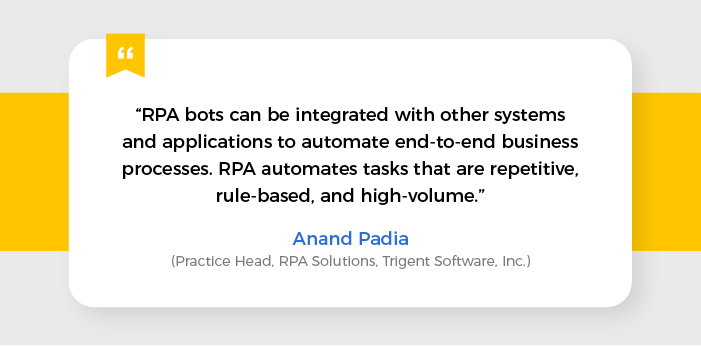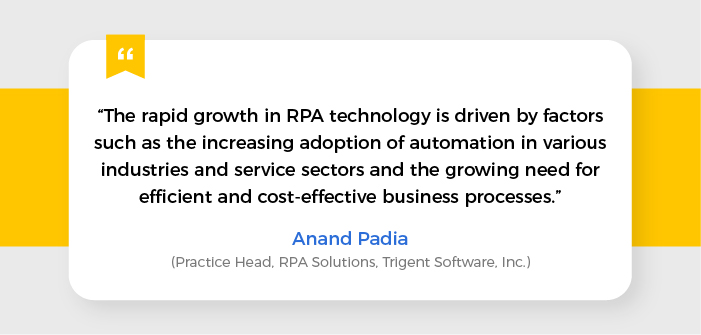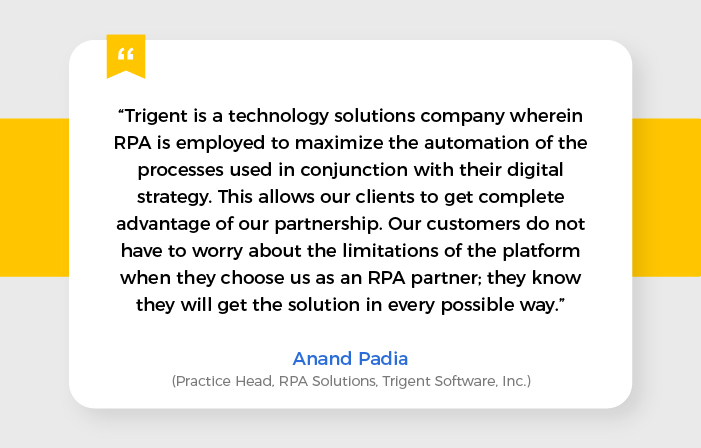Robotic Process Automation is a transformative technology that automates end-to-end business processes using APIs, user interface interactions, and advanced software bots. Robotic Process Automation streamlines and simplifies the workflow, enabling users to interact with digital systems easily. RPA helps to unleash digital transformation, automate repetitive tasks, improve overall organizational productivity, and enhance employee engagement. RPA may integrate sub-fields of artificial intelligence, machine learning, and natural language processing, but it differs from AI. AI is a data-driven solution, while RPA complies with user-defined processes. Its core capabilities include orchestration and administrative tasks, and seamless integration with third-party software applications, and building automation scripts using low-code capabilities.
GoodFirms Roundtable is a series of podcast discussions where our experts interact with top business and industry leaders and discuss diverse topics with them, specifically related to IT services and the latest industry trends. The information shared provides value to all young entrepreneurs planning to start their ventures.
For this current podcast discussion, GoodFirms had the opportunity to interact with Anand Padia, Practice Head, RPA Solutions, Trigent Software, Inc.
Trigent Software is a US-based technology services company established in 1995. The company holds expertise in diversified areas, including application development, data engineering, cloud services, infrastructure services, custom software development, UI/UX designing, Microsoft implementation, quality engineering, RPA, and more. It also works on core and disruptive technologies to build and deliver high-quality products that provide businesses a competitive edge over others.
The podcast discussion highlights the following points:
- Relevance of Robotic Process Automation in Hyper-automation
- A few scenarios of how RPA can streamline the business process?
- The current and futuristic RPA industry trends
- Examples wherein RPA is effectively implemented
- How to ensure data security and compliance while implementing RPA?
Also, this podcast discussion provides information on the following topics
- Potential challenges while implementing RPA
- Ethical implications and a few myths versus realities while implementing RPA
- How to measure the success of RPA implementation?
- How GoodFirms helped Trigent Software beat the competition and emerge as the best?
Can you shed some light on the relevance of Robotic Process Automation (RPA) in a disruptive technology like hyper-automation?
Hyper-automation is the umbrella term that comprises several next-generation technologies, such as Machine Learning (ML), Artificial Intelligence (AI), Intelligent Automation (IA), Robotic Process Automation (RPA), etc. RPA leverages software robots, typically referred to as bots, designed to emulate/mimic the repetitive actions of a human, such as interacting with software applications, navigating web pages, and performing calculations.
RPA with AI/ML will compositely deliver Intelligent Automation. You can automate a complex process using both RPA and AI to develop a system that extracts data from multiple sources, perform complicated calculations, and makes data-driven decisions.
Consider an example of the working process of a financial institution that receives a loan application and then processes it. You can use the RPA boat to extract data from the application form, verify it against external sources, and pass it to an AI model. The AI model analyzes the creditworthiness of the applicant using past data and other internal and external factors.

In simpler terms, for a better understanding of our audience, can you discuss a scenario where RPA can be used to streamline a business process?
Here is a scenario where a retail sector uses Robotic Process Automation to streamline its business processes.
A retail store receives humongous amounts of invoices from their vendors and suppliers that they may lose control over. Hence they often have to extract the data manually and enter it into their CRM or ERP system.
RPA provides Optical Character Recognition (OCR) solution, which helps to dig out the invoice data and validate the same against pre-defined rules and enter it into the CRM/ERP system.
However, in case of exceptions, the system can flag it for manual review. But the automated process generates reports and analytics based on vendor performance, processing time, and exceptions, enabling organizations to make data-driven decisions.

Similarly, we can take another use case where the company is looking to streamline the distribution of Amazon vouchers to present as a New Year gift to their employees.
In this case, the employees have to enter the information manually, like their names, email addresses, etc., into the voucher disbursement system. It becomes a time-consuming and tedious process, which may lead to errors and delays. The RPA software could be programmed to capture the employee information from the company's HR database and automatically generate and send the Amazon vouchers to each employee's email address.

While we are digging deeper into this subject and discussing RPA, we would like to know what the RPA market actually looks like? Can you give insights on current and future trends in the industry?
According to a recent market research report, the global RPA market is expected to grow to $10.82 billion by 2025 at a CAGR of 42.2%. In the next three to five years, the RPA industry is heading towards adopting the following next-generation technologies. These include
- Increasing the adoption of cloud-based RPA: Several companies are migrating from on-premises RPA solutions and opting for cloud-based solutions to take advantage of the scalability and flexibility they offer.
- Integration with AI and Machine Learning: RPA is integrating with AI and machine learning to bring about more advanced and efficient automation processes. This integration enables businesses to automate routine jobs and tasks that require decision-making and judgment.
- Increasing focus on security & data integrity: Companies are using RPA for more critical and sensitive processes. Hence, the focus is on RPA security solutions to protect sensitive data.
- Development of RPA-as-a-service: We can expect to see more RPA solutions offered as a service in various industries such as healthcare, education, and government, which will make it easier for companies to adopt RPA without having to invest in the infrastructure and resources required to implement it.
- Increased integration with AI and Machine Learning: We can expect to see the development of more intelligent and adaptive RPA bots that can learn from their interactions and adapt to changing conditions.
- Increased use of Natural Language Processing: We may see more RPA solutions that incorporate natural language processing capabilities, allowing RPA bots to understand and respond to human language more effectively.

Can you give us some industry examples wherein RPA is effectively implemented?
I believe that all PRA projects have two common objectives.
- First to save costs
- Second to improve the quality.
For instance, in the BFSI sector- we have a transaction process like onboarding a customer, then we may have CSR executives gathering customer data with regard to KYC, credit checks, etc. RPA satisfies both the above-mentioned objectives as it reduces manual effort, in turn saving operational costs as well as allows a company to maintain consistent quality of customer data records.
A similar process follows when it comes to using Purchase Order Management systems in the manufacturing industry. Existing customers often submit their orders through emails with PO (purchase order) as PDF or over a call. By leveraging RPA, we can automate the entire workflow, including the PDF entry or online form/email following the standard format, which would be useful for risk mitigation.
RPAs work in a way where it accesses information from different systems and integrates with other applications through frontend integrations. In such scenarios, how do companies ensure data security and compliance when implementing RPA?
Companies can take the following necessary steps to ensure data security and compliance when implementing RPA. These include:
- Access controls: Companies can implement access controls to ensure that only authorized personnel have access to sensitive information and that RPA bots are only accessing the required information they need to complete their tasks.
- Encryption: Organizations can encrypt data to protect sensitive information, both in transit and at rest.
- Auditing and Logging: Auditing and logging help to track the RPA actions and bots, ensuring companies meet compliance with regulations. It also allows them to identify and respond to any security incidents that may occur.
- Risk assessment: Companies can conduct risk assessments to identify potential security threats and vulnerabilities associated with RPA implementation and take appropriate measures to mitigate them.
- Compliance with Regulations: Companies should ensure that their RPA implementation adheres to relevant regulations such as GDPR, HIPAA, SOC2, and others.
- Regular Updates and Maintenance: Regularly updating RPA software and infrastructure can help ensure compliance and prevent security vulnerabilities.

While RPA ensures to support mundane tasks and helps people like us move on to more complex tasks, Can you discuss any pitfalls that companies may face when implementing RPA?
In addition to ensuring data security previously discussed, companies may face several challenges when implementing RPA. These include
- Integration with existing systems: Integrating RPA bots with existing systems and applications can become a challenging task. It may require significant IT resources and expertise.
- Scalability: With increased numbers of RPA bots and their automated processing capabilities, companies may face issues related to scaling their RPA implementations to meet the growing demands of the business.
- Lack of standardization: The lack of standardization in the RPA industry, which can make it difficult for companies to compare and choose the right RPA solution for their needs.
- Change management: Implementing RPA can require significant changes to existing business processes and organizational structures, which may be challenging for some companies to manage.
- Integration with AI and ML: While you can integrate RPA with artificial intelligence and machine learning to automate complex tasks, the implementation can become a challenging aspect as it requires a different set of skills and expertise.
- Limited flexibility: RPA bots are typically designed to follow a set of rules and instructions, which can make them less flexible than human workers in certain situations.

Are there any ethical implications of RPA, if yes, how companies can address them? Can you discuss some myths versus the reality of implementing RPA?
Here, I’m highlighting a few myths associated with RPA implementation. These are
Myth 1: RPA is a quick fix for every problem.
Reality 1: RPA requires planning and process reengineering to realize full benefits.
Myth 2: RPA will replace human resources.
Reality 2: RPA will enhance resources by freeing employees to focus more on strategic or tactical tasks.
Myth 3: RPA does not require change management.
Reality 3: RPA in itself is a process change, so it definitely requires change management, process/SOP updates, and training.
Myth 4: Cost-saving is the only benefit of RPA.
Reality 4: In addition to cost-effectiveness, RPA is instrumental in streamlining business services, indirectly allowing them to improve quality, customer experience, and satisfaction, both internally and externally.
Myth 5: RPA is applicable to any business process/ workflow.
Reality 5: RPA cannot be applied to all business processes; the organization must implement a decision-based RPA solution, thus breaking it down to solve the manual effort. However, it cannot replace every process/workflow.

How do you measure the success of RPA Implementation? Can you explain this with an application of RPA specific to a certain industry?
To efficiently and accurately measure the success of RPA implementation, you can evaluate various metrics. Let’s take the example of the healthcare industry where a hospital can implement RPA to automate the process of scheduling appointments. Thus, the hospital administration can measure the success of RPA implementation by evaluating the following metrics.
- Return on Investment (ROI): By automating the scheduling process, the hospital can save labor costs and increase revenue.
- Process Completion Time: The hospital can measure the time taken for RPA bots to schedule an appointment and compare it to the time taken by a human scheduler to schedule an appointment.
- Error Rate: The hospital can take into account the number of errors that occurred during the scheduling process.
- Compliance: It can measure the degree to which the RPA implementation adheres to relevant regulations and standards, such as HIPAA, to ensure that patient information is protected.

The RPA adoption rates are rapidly increasing, and this industry is forecasted to generate a total of around $10.8 Billion by 2025. This means there is an immense demand for the best RPA development firm. Please let us know how GoodFirms help you beat the competition and help Trigent Software emerge as the best.
Getting listed on GoodFirms has helped us gain credibility and trust among potential clients. We can stay updated on the latest trends and insights in the RPA industry, connect with other leading companies in the market, and, most importantly, remain competitive and continuously improve our RPA services.

If you want to listen to the full podcast conversation, click here.
What’s Next?
Robotic Process Automation has grown exceedingly in the current landscape and is set to become one of the most extensively used futuristic technologies in the coming years. One of the prime reasons why businesses of all types and sizes are getting RPA-ready is they all want to unleash the comprehensive RPA benefits and become dominant leaders in their industry domains. With improved integration capabilities and wider usage of AI solutions, the performance of RPA tools and systems will upscale further to augment customer satisfaction to the highest level.
You can also enroll your company’s name for the next Roundtable podcast discussion to share your thoughts and experiences on any topic. Just send us an email at [email protected].



